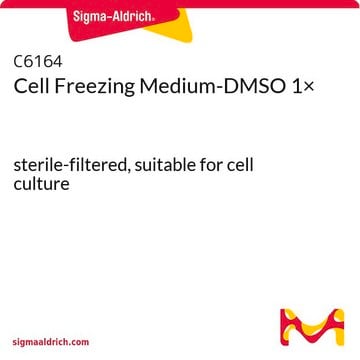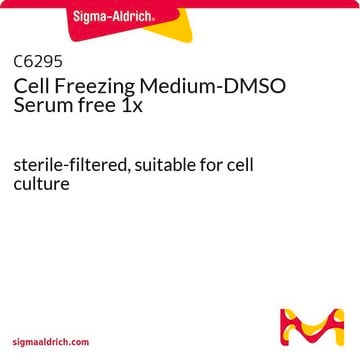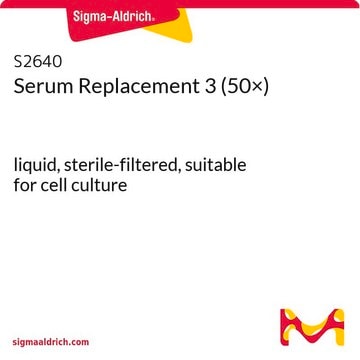Z1653
pZerve™
Cryopreservation Solution
Synonym(s):
DMSO-free freezing solution
Sign Into View Organizational & Contract Pricing
All Photos(1)
About This Item
UNSPSC Code:
12352207
NACRES:
NA.75
Recommended Products
technique(s)
cryopreservation: suitable
storage temp.
2-8°C
Related Categories
General description
pZerve is a cryopreservation solution that does not contain dimethyl sulfoxide (DMSO), fetal bovine serum or other animal protein. Optimal recovery is achieved through elimination of these harmful components. pZerve is ready to use, does not require any dilution or further processing, and can be used for cells cultured in serum free medium or with serum containing medium.
Application
pZerve has been successfully used with the following cell types including, but not limited to:
- Mast Cells
- Dendritic Cells
- Mesenchymal Cells
- LNCaP – Metastatic Prostate Adenocarcinoma, Human
- LS 180 – Colon, Adenocarcinoma, Human
- 293 – Transformed Primary Embryonal Kidney, Human
Preparation Note
Recommended Freezing and Thawing Protocol
Freezing:
1. Examine the culture for healthy growth, confluency, etc. and the absence of contamination.
2. If freezing adherent cells, remove using 0.25% trypsin for 1 to 3 minutes at 37 °C.
NOTE: Some cell lines grown in serum-free medium may be sensitive to 0.25% trypsin and therefore, may require less trypsin or the addition of a trypsin inhibitor. Wash cells after incubating with trypsin.
3. Perform a cell count to determine the total number of viable cells. Cell viability should be greater than 80%, and cells should be in late log phase or pre-confluency growth phase.
4. Centrifuge cells at 600 to 800 RPM for 10 minutes. Remove supernatant and save 3 to 5 mL for sterility testing (e.g. thioglycollate, brain heart infusion, etc.) and mycoplasma testing.
5. Resuspend the cells gently in an appropriate volume of pZerve at a concentration of 1x106 - 1x107 cells/ml. Some cell types such as hybridomas and myelomas may require an increase in cell density.
6. Dispense the cell suspension in 1 to 2 mL aliquots in plastic or glass ampules.
7. Seal ampules and store at room temperature for 30 minutes with occasional, gentle agitation to expose cells completely to cryopreservative.
8. Place ampules in an insulated container and store in a -20°C freezer for one hour. Remove insulation and transfer to -70 °C freezer for one hour. Do not store at -70 °C for more than two hours. Transfer vials to vapor phase of liquid nitrogen and store for 24 hours before transferring to liquid phase. The suggested optimum cooling rate is 1 °C per minute for most cell types.
Recovery:
1. Remove vials from freezer and rapidly thaw in a 37 °C water bath.
2. Wipe vials with 70% ethanol.
3. Transfer cells to a culture flask and slowly add the appropriate volume of growth medium (2 to 5 mL).
4. Accurate viability counts (i.e., trypan blue dye exclusion) should be performed after at least 2 hours recovery at 37 °C.
5. Medium should be changed within 24 hours.
If desired, pZerve may be removed by washing in the following manner:
1. Transfer cells to a 15ml centrifuge tube and slowly add 2 to 3 mL of complete growth medium (cells are more fragile after thawing).
2. Centrifuge at 400 to 600 RPM for approximately 5 minutes.
3. Decant and transfer the cells to a culture flask with the appropriate volume of growth medium.
4. Cell viability count should be performed at least two hours after recovery.
IMPORTANT: Before terminating a culture, it is recommended that you test entire freeze/thaw cycle to ensure sterility of the culture and cell viability before long term storage.
Freezing:
1. Examine the culture for healthy growth, confluency, etc. and the absence of contamination.
2. If freezing adherent cells, remove using 0.25% trypsin for 1 to 3 minutes at 37 °C.
NOTE: Some cell lines grown in serum-free medium may be sensitive to 0.25% trypsin and therefore, may require less trypsin or the addition of a trypsin inhibitor. Wash cells after incubating with trypsin.
3. Perform a cell count to determine the total number of viable cells. Cell viability should be greater than 80%, and cells should be in late log phase or pre-confluency growth phase.
4. Centrifuge cells at 600 to 800 RPM for 10 minutes. Remove supernatant and save 3 to 5 mL for sterility testing (e.g. thioglycollate, brain heart infusion, etc.) and mycoplasma testing.
5. Resuspend the cells gently in an appropriate volume of pZerve at a concentration of 1x106 - 1x107 cells/ml. Some cell types such as hybridomas and myelomas may require an increase in cell density.
6. Dispense the cell suspension in 1 to 2 mL aliquots in plastic or glass ampules.
7. Seal ampules and store at room temperature for 30 minutes with occasional, gentle agitation to expose cells completely to cryopreservative.
8. Place ampules in an insulated container and store in a -20°C freezer for one hour. Remove insulation and transfer to -70 °C freezer for one hour. Do not store at -70 °C for more than two hours. Transfer vials to vapor phase of liquid nitrogen and store for 24 hours before transferring to liquid phase. The suggested optimum cooling rate is 1 °C per minute for most cell types.
Recovery:
1. Remove vials from freezer and rapidly thaw in a 37 °C water bath.
2. Wipe vials with 70% ethanol.
3. Transfer cells to a culture flask and slowly add the appropriate volume of growth medium (2 to 5 mL).
4. Accurate viability counts (i.e., trypan blue dye exclusion) should be performed after at least 2 hours recovery at 37 °C.
5. Medium should be changed within 24 hours.
If desired, pZerve may be removed by washing in the following manner:
1. Transfer cells to a 15ml centrifuge tube and slowly add 2 to 3 mL of complete growth medium (cells are more fragile after thawing).
2. Centrifuge at 400 to 600 RPM for approximately 5 minutes.
3. Decant and transfer the cells to a culture flask with the appropriate volume of growth medium.
4. Cell viability count should be performed at least two hours after recovery.
IMPORTANT: Before terminating a culture, it is recommended that you test entire freeze/thaw cycle to ensure sterility of the culture and cell viability before long term storage.
Other Notes
- pZerve only contains human protein.
- pZerve is ready to use an does not require any dilution or further processing.
- pZerve is sterile membrane filtered.
- Mix well before use.
- DO NOT DILUTE.
Legal Information
pZerve is a trademark of Protide Pharmaceuticals, Inc.
Storage Class Code
12 - Non Combustible Liquids
WGK
WGK 3
Flash Point(F)
Not applicable
Flash Point(C)
Not applicable
Certificates of Analysis (COA)
Search for Certificates of Analysis (COA) by entering the products Lot/Batch Number. Lot and Batch Numbers can be found on a product’s label following the words ‘Lot’ or ‘Batch’.
Already Own This Product?
Find documentation for the products that you have recently purchased in the Document Library.
Customers Also Viewed
Madeleine Rådinger et al.
Current protocols in immunology, Chapter 7, Unit 7-Unit 7 (2010-09-04)
Antigen-mediated mast cell activation is a pivotal step in the initiation of allergic disorders including anaphylaxis and atopy. To date, studies aimed at investigating the mechanisms regulating these responses, and studies designed to identify potential ways to prevent them, have
Arnold S Kirshenbaum et al.
Leukemia research, 27(8), 677-682 (2003-06-13)
Two novel stem cell factor (SCF) dependent human mast cell lines, designated LAD 1 and 2, were established from bone marrow aspirates from a patient with mast cell sarcoma/leukemia. LAD 1 and 2 cells have the ultrastructural features of human
Our team of scientists has experience in all areas of research including Life Science, Material Science, Chemical Synthesis, Chromatography, Analytical and many others.
Contact Technical Service










